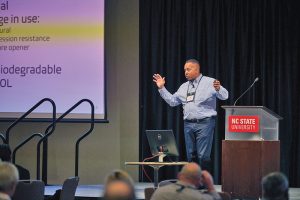
Recycling and sustainability took center stage at INDA’s 2022 Rise® Conference.
By Jim Kaufmann, Contributing Editor
If the recent 2022 Research, Innovation & Science For Engineered Fabrics (RISE) Conference — organized by the Association of the Nonwoven Fabrics Industry (INDA) and held at NC State University in Raleigh, N.C.— were to be made into a book or movie, it undoubtedly would become a hit because this year’s conference had something to suit everyone’s tastes. Presentations offered tidbits of mystery, intrigue, comedy, suspense and truly compelling storylines. Interesting concepts, technologies and products were presented; theories were offered; and some puzzling questions were raised, mostly centered on the conundrum of circularity, recycling and sustainability.
For those present, the conference may have raised more questions than answers. But it was refreshing to see that some of the tough, unspoken questions were asked. One question that stood out was, “Is the recycling effort broken”? Unfortunately, the general consensus appeared to be yes. “The economics of recycling is our biggest challenge,” offered Dr. Jason Locklin, University of Georgia’s director at the New Materials Institute. “It takes a very large infrastructure, which truly isn’t in place, to effectively gather and recycle products at any realistic level.” He and others further reasoned that legislation specific to recycling and sustainability can be a good thing if the legislators are properly informed. However, there currently appears to be a disconnect between many of the certification bodies and actual reality.
Recycling options were discussed and filtered into three main streams of circularity — chemical recycling, mechanical recycling and composting. Each offer potential opportunities and show promise, but each also presents drawbacks. Suggestions were made that we need to “consider the origin of materials as well as the after-use possibilities” of items we purchase in order to further streamline the options for achieving circularity.
Biopolymer opportunities were discussed in several talks. What is clear, according to Benham Pourdeyhimi, executive director of The Nonwovens Institute: “Biopolymers are not the full solution. They’re only part of the solution.” It was suggested in several presentations that there is a need for more companies producing biomaterials, such as polylactic acid, because competition is good and this drives interest, volumes and ultimately innovation throughout the supply chain.
A growing variety of natural fibers have seen a rise in popularity as sustainable alternatives to man-made fibers, however they aren’t without challenges. According to Paul Latten, director of Research and Development at Southeast Nonwovens: “A more holistic view of sustainability is needed. Natural fibers are mostly straight and uncrimped, which does present issues in textile processing. Hemp fiber cost is currently two times that of polyester and the costs of other natural fibers may be even higher, but ultimately the decisions around natural fiber usage and sustainability in general will come down to personal choices and behavior. The question really becomes ‘what are we willing to do differently?’”
The contrasting views of the presenters could best be summed up by “Here’s how we save the future” versus “The recycling system is broken, we need to fix it.” Unfortunately, the challenges we face were truly made clear when one of the presenters stated, “If it costs more or performs less, we humans likely won’t use it.”
Three facts garnered during the conference really stood out:
- In 2020 alone, 1.6 billion disposable masks entered the ocean;
- Every minute, 300,000 disposable diapers are landfilled or incinerated; and
- It takes 450 years for polyester to biodegrade!
As Dr. Locklin stated, “It’s really hard to do the right thing,” but hopefully, we’re finally asking the right questions.
November/December 2022




